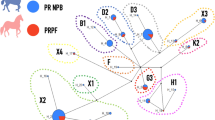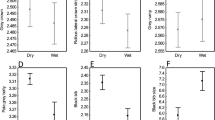Abstract
Wild horses unexpectedly survived terminal Pleistocene megafaunal extinctions until eventual European extirpation in the twentieth century. This survival is tied to either their occurrence in cryptic open habitats or their adaptation to forests. Our niche modelling inferred an increasing presence of horses in post-glacial forests, and our analysis of ancient DNA suggested significant selection for black phenotypes as indicating adaptation to forests.
This is a preview of subscription content, access via your institution
Access options
Access Nature and 54 other Nature Portfolio journals
Get Nature+, our best-value online-access subscription
$29.99 / 30 days
cancel any time
Subscribe to this journal
Receive 12 digital issues and online access to articles
$119.00 per year
only $9.92 per issue
Buy this article
- Purchase on Springer Link
- Instant access to full article PDF
Prices may be subject to local taxes which are calculated during checkout


Similar content being viewed by others
References
Sommer, R. S., Benecke, N., Lõugas, L., Nelle, O. & Schmölcke, U. J. Quat. Sci. 26, 805–812 (2011).
Guthrie, R. D. Nature 426, 169–171 (2003).
Koch, P. L. & Barnosky, A. D. Annu. Rev. Ecol. Evol. Syst. 37, 215–250 (2006).
Lorenzen, E. D. et al. Nature 479, 359–364 (2011).
Weniger, G. C. J. World Prehist. 3, 323–372 (1989).
Shafer, A. B. et al. Trends Ecol. Evol. 30, 78–87 (2015).
Bendrey, R. J. Biogeogr. 41, 1441–1442 (2014).
Trondman, A. K. et al. Glob. Change Biol. 21, 676–697 (2015).
Davis, B. A. S., Collins, P. M. & Kaplan, J. O. Veg. Hist. Archaeobot. 24, 303–317 (2015).
Prins, H. H. T. in Grazing and Conservation Management (eds WallisDe Vries, M. F., Bakker, J. P. & Van Wieren, S. E.) 55–105 (Springer, Dordrecht, 1998).
Librado, P. et al. Genetics 204, 423–434 (2016).
Vera, F. W. M. Grazing Ecology and Forest History (CABI, Oxford, 2000).
Warmuth, V. et al. PLoS ONE 6, e18194 (2011).
Ludwig, A. et al. Phil. Trans. R. Soc. B 370, 20130386 (2015).
Wutke, S. et al. Sci. Rep. 6, 38548 (2016).
Caro, T. BioScience 55, 125–136 (2005).
Larison, B. et al. R. Soc. Open Sci. 2, 140452 (2015).
Anderson, T. M. et al. Science 323, 1339–1343 (2009).
Librado, P. et al. Science 356, 442–445 (2017).
Bennett, D. & Hoffmann, R. S. Mamm. Species 628, 1–14 (1999).
Binney, H. et al. Quat. Sci. Rev. 157, 80–97 (2017).
Reissmann, M., Musa, L., Zakizadeh, S. & Ludwig, A. J. Appl. Genet. 57, 519–525 (2016).
González-Salazar, C., Stephens, C. R. & Marquet, P. A. Ecol. Model. 248, 57–70 (2013).
Stephens, C. R. et al. PLoS ONE 4, e5725 (2009).
Fyfe, R. M. et al. Veg. Hist. Archaeobot. 18, 417–424 (2009).
Ludwig et al. Science 324, 485 (2009).
Dabney, J. et al. Proc. Natl Acad. Sci. USA 110, 15758–15763 (2013).
Sandoval-Castellanos, E. Genet. Res. 92, 309–320 (2010).
Beaumont, M. A. Annu. Rev. Ecol. Evol. Syst. 41, 379–406 (2010).
Schraiber, J. G., Evans, S. N. & Slatkin, M. Genetics 203, 493–511 (2016).
Acknowledgements
We thank C. Yurrita and L. Dalén for feedback on early versions of the manuscript. This project was supported by the Deutsche Forschungsgemeinschaft (LU852/7-4).
Author information
Authors and Affiliations
Contributions
A.L. planned the project. A.L. and E.S.-C. designed the study. S.W. provided and processed the ancient genotypes. S.W. and E.S.-C. analysed the ancient DNA data set. C.G.-S. carried out the niche modelling analysis. E.S.-C. and A.L. wrote the manuscript. All authors gave final approval for the publication.
Corresponding author
Ethics declarations
Competing interests
The authors declare no competing financial interests.
Additional information
Publisher’s note: Springer Nature remains neutral with regard to jurisdictional claims in published maps and institutional affiliations.
Electronic supplementary material
Supplementary Information
Supplementary tables, figures and methods
Rights and permissions
About this article
Cite this article
Sandoval-Castellanos, E., Wutke, S., Gonzalez-Salazar, C. et al. Coat colour adaptation of post-glacial horses to increasing forest vegetation. Nat Ecol Evol 1, 1816–1819 (2017). https://doi.org/10.1038/s41559-017-0358-5
Received:
Accepted:
Published:
Issue Date:
DOI: https://doi.org/10.1038/s41559-017-0358-5
This article is cited by
-
Lack of support for adaptation of post-glacial horses to woodlands
Nature Ecology & Evolution (2018)



